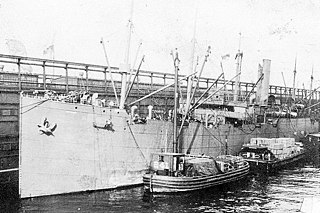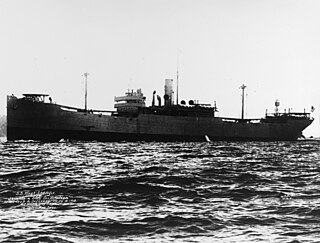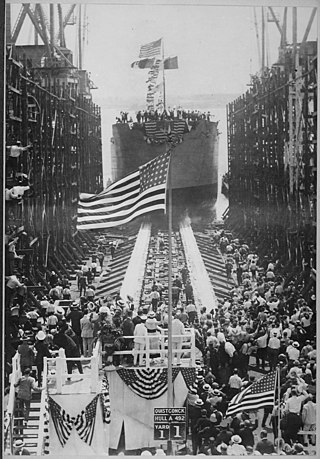
SS Timothy Bloodworth was a standard Liberty ship built for the United States Maritime Commission during World War II. The vessel was built by Delta Shipbuilding Company of New Orleans in 1943. She was named in honor of Timothy Bloodworth, an American teacher who made muskets and bayonets during the American Revolutionary War, then went on to become a statesman in North Carolina.

The SS Empire Miniver was a British steam merchant ship. She was originally an American merchant, launched in 1918 as SS West Cobalt. During a brief stint in the United States Navy in 1919, she was known as USS West Cobalt (ID-3836).

Empire Bittern was a steamship, built as a livestock-carrying cargo ship in 1902 at Belfast, Ireland as Iowa for the White Diamond Steamship Company Ltd of Liverpool. The ship was sold to the Hamburg America Line and renamed Bohemia in 1913.

SS Empire Simba was a British steam-powered cargo ship. She was originally an American ship, launched in 1918 as SS West Cohas. During a stint in the United States Navy from 1918 to 1919, she was called USS West Cohas (ID-3253).

USS West Lianga (ID-2758) was a cargo ship for the United States Navy during World War I. She was later known as SS Helen Whittier and SS Kalani in civilian service under American registry, as SS Empire Cheetah under British registry, and as SS Hobbema under Dutch registry.
SS Empire Advocate was a 5,787 ton steamship which was built in 1913 as the Solfels. She was taken as war reparations in 1919 and renamed Bowes Castle in 1920. In 1932 she was sold to Italy, being renamed Angelina Lauro, being seized in 1940 and renamed Empire Advocate. She was scrapped at Bo'ness in 1945.
SS Empire Bunting was a 6,318 GRT cargo ship which was built in 1919. She saw service between the wars under the US flag and was transferred to the UK Ministry of War Transport in the Second World War. She made a number of cross-Atlantic voyages, often sailing in convoys. She ended her career by being sunk as a blockship on the Normandy coast, supporting the allied landings there in 1944.
Empire Barracuda was a 4,972 GRT cargo ship which was built in 1918 for the United States Shipping Board (USSB) as Sacandaga. She was sold to American Diamond Lines in 1932 and renamed Black Heron. In 1941 she passed to the Ministry of War Transport (MoWT) and was renamed Empire Barracuda. She was torpedoed on 15 December 1941 and sunk by U-77.
Norhauk was a 6,086 GRT refrigerated cargo ship which was built to Design 1015 by G. M. Standifer Construction Company, Vancouver, Washington in 1919 as Waban for the United States Shipping Board (USSB). After service with Lykes Brothers-Ripley Steamship Co Inc she was transferred to the Ministry of Shipping in 1940 and renamed Empire Sambar. A boiler-room explosion damaged her in 1941. After repairs she was renamed Empire Beaver. She was transferred to the Norwegian Government in 1942 and renamed Norhauk, serving until she struck a mine and sank in December 1943.
Empire Buffalo was a 6,404 GRT Design 1105 cargo ship which was built in 1919 as Eglantine by Skinner & Eddy for the United States Shipping Board (USSB). She was sold in 1933 to the Lykes Brothers-Ripley Steamship Corporation. In 1940 she was sold to the Ministry of War Transport (MoWT) and renamed Empire Buffalo. She was torpedoed and sunk by U-125 in 1942.
Empire Crossbill was a 5,463 GRT Design 1013 cargo ship that was completed in 1919 by Los Angeles Shipbuilding & Drydock Company, San Pedro, California, United States for the United States Shipping Board (USSB). She was transferred to the United States Maritime Commission (USMC) in 1937 and the Ministry of Transport (MoT) in 1941, serving until she was torpedoed and sunk on 11 September 1941 by U-82 in the Atlantic Ocean while a member of Convoy SC 42.
Empire Dabchick was a 5,995 GRT Design 1019 cargo ship that was built in 1919 as Kisnop by Atlantic Corporation, Portsmouth, New Hampshire, United States for the United States Shipping Board (USSB). She was transferred to the United States Maritime Commission (USMC) in 1937. In 1940 she was transferred to the Ministry of War Transport (MoWT) and renamed Empire Dabchick. She served until December 1942, when she was torpedoed and sunk by German submarine U-183.
Empire Dorado was a 5,595 GRT design 1019 cargo ship that was built in 1920 as Tolosa by Atlantic Corporation, Portsmouth, New Hampshire, United States for the United States Shipping Board (USSB), passing to the United States Maritime Commission (USMC) in 1937. She was sold to the United Kingdom in 1940, passed to the Ministry of War Transport (MoWT) and renamed Empire Dominica. She served until November 1941, when she was in collision with another ship. Although taken in tow, she subsequently sank.
Norlom was a 6,326 GRT Design 1105 cargo ship that was built in 1919 as Editor by Skinner & Eddy Corporation, Seattle, Washington, United States for the United States Shipping Board (USSB), which became the United States Maritime Commission (USMC) in 1937. In 1941, she was transferred to the British Ministry of War Transport (MoWT) and renamed Empire Dunlin. She was transferred to Norway in 1942 and renamed Norlom. She served until 2 December 1943 when she was bombed and sunk at Bari, Italy.
Norjerv was a 5,583 GRT cargo ship that was built in 1919 as West Islip by Ames Shipbuilding & Dry Dock Co, Seattle, Washington, United States for the United States Shipping Board (USSB). In 1928, she was sold and renamed Golden Rod. A further sale in 1935 saw her renamed Willhilo. She was renamed Indianan after a sale in 1937. In 1940, she was transferred to the Ministry of Supply (MoS) and renamed Empire Eagle, passing later that year to the Ministry of War Transport (MoWT). In 1942, she was transferred to the Norwegian Government and renamed Norjerv, serving until June 1944 when she was transferred to the British Government. In July 1944, she was sunk as a blockship at Juno Beach, Calvados, France to reinforce Gooseberry 4.
Empire Eland was a 5,613 GRT Design 1019 cargo ship that was built in 1920 as West Kedron by Long Beach Shipbuilding Co, Long Beach, California, United States for the United States Shipping Board (USSB). She was transferred to the United States Maritime Commission (USMC) in 1937. In 1940, she was transferred to the Ministry of War Transport (MoWT). She was torpedoed and sunk by U-94 on the night of 15–16 September 1941.
Norvarg was a 4,748 GRT Design 1014 refrigerated cargo ship that was built in 1920 as Rotarian by the Todd Dry Dock and Construction Company, Tacoma, Washington, United States for the United States Shipping Board (USSB). She was sold to the Grace Steamship Co Inc, New York in 1923 and renamed Condor. In 1940, she was sold to the British Ministry of Shipping (MoS), which became the Ministry of War Transport (MoWT) in 1941, and was renamed Empire Elk. In 1942, she was transferred to the Norwegian Government and renamed Norvarg.

Empire Faith was a 7,061 GRT CAM ship that was built in 1941 by Barclay Curle & Co, Glasgow, Renfrewshire, United Kingdom for the Ministry of War Transport (MoWT). Converted to a cargo ship in 1943, she was sold to a British company in 1946 and renamed Jessmore. In 1958, she was sold to a Panamanian company and renamed Antiope. A further sale in 1964 saw her renamed Global Venture. She served until 1971, when she was scrapped.

Quistconck was a 5,144 GRT Design 1022 Hog Islander that was laid down as Red Jacket in 1918 by the Stone & Webster subsidiary American International Shipbuilding Corp., Hog Island, Philadelphia, Pennsylvania, United States for the United States Shipping Board (USSB). Launched as Quistconck, she was sold to Lykes Brothers - Ripley Steamship Co Inc in 1933. In 1941, she was passed to the Ministry of War Transport (MoWT) and renamed Empire Falcon. She was sold into merchant service in 1946 and renamed Barnby. A sale to a Panamanian company saw her renamed Mariandrea. She served until 1953, when she was scrapped.
Cockaponset was a steam cargo ship built in 1918–1919 by Pacific Coast Shipbuilding Company of Bay Point for the United States Shipping Board as part of the wartime shipbuilding program of the Emergency Fleet Corporation (EFC) to restore the nation's Merchant Marine. The vessel was largely employed on the Gulf Coast of the United States to Europe route until 1930 when she was laid up. In late 1940 the ship together with 15 other vessels was acquired by the British government to alleviate significant shortage of tonnage due to an ongoing German U-boat campaign. In May 1941 the freighter was torpedoed and sunk on her first war trip to the United Kingdom.









